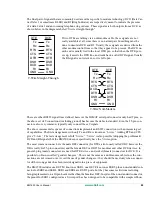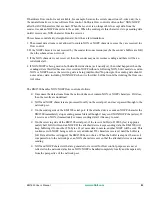
EM1500 User’s Manual
87
B. S
ERIAL
AND
TCP P
ROTOCOLS
To realize the full potential of the EM1500, it is necessary to have some knowledge of serial and TCP pro-
tocols. This appendix discusses both topics. There is a detailed description of the difference between a
straight-through serial cable and a null-modem serial cable.
B.1 Serial Protocols
RS232 asynchronous serial is a well established standard for computer communication. It was initially
intended specifically for computers and terminals to connect to “modems” which would convert the data
stream into a format suitable for long-haul communications over telephone or leased lines. Much of the
terminology of RS232 is founded in the computer/modem concept. For example, computers, printers, and
terminals are classed as DTE (Data Terminal Equipment). The modem is a DCE (Data Communication
Equipment).
RS232 was relatively easy and inexpensive to implement, so it soon found its way into applications other
than long-distance data transfer. Unfortunately, there is still a lot of confusion because of this. With the
advent of the IBM PC (and AT), most DTE implementations settled on a standard connector and set of sig-
nal lines. This does not eliminate the confusion but helps minimize it.
The following discussion focuses on the electrical connections between two RS232 devices. Once this is
established, we talk about the data signalling conventions.
B.1.1 Serial Port Signal Names and Directions
At its most basic, RS232 requires two data signal lines and a common (“ground”) connection. One of the
signal lines, Tx, is used for transmitting data from the DTE to the DCE. The other, Rx, is used for receiv-
ing data from the DCE to the DTE. All signal names are from the point of view of the DTE. Thus, Tx is a
DTE output but a DCE input, and similarly Rx is a DTE input but a DCE output:
The confusion arises when two DTE devices are trying to talk to each other.
In this case, the Tx line cannot be wired straight through as it could with the
DTE/DCE configuration pictured on the left.
The picture to the right is the most basic null-
modem cable. A null-modem cable is used whenever two DTEs need to talk
directly to one another. A new level of complexity is introduced when the
other so-called modem control lines are introduced.
The most important modem control lines are CTS (Clear To Send) and RTS
(Request To Send). These are used for hardware flow control. Flow control is
described in greater detail below. The CTS/RTS pair has a certain symmetry,
DTE
Tx
Tx
Rx
Rx
GND
GND
DCE
3-Wire Straight-Through
DTE
Tx
Tx
Rx
Rx
GND
GND
DTE
3-Wire Null-Modem
Содержание EM1500
Страница 14: ...10 www rabbit com Introduction...
Страница 22: ...18 www rabbit com Getting Started...
Страница 76: ...72 www rabbit com EM1500 Configuration...
Страница 90: ...86 www rabbit com EM1500 Specifications...
Страница 104: ...100 www rabbit com Serial and TCP Protocols...
Страница 118: ...114 www rabbit com EM1500 FAQ...
















































